PETER COMESTOR (d. c.1178). Historia Scholastica , in Latin, ILLUMINATED MANUSCRIPT ON VELLUM [England, c.1200] 315 x 210mm. 165 leaves: 1 7 (of 8, lacking i), 2-5 8 , 6 7 (of 8, lacking vi), 7 9 , 8-20 8 , 21 7 (of 8, lacking viii), with roman quire numbers on final versos of several gatherings, two columns of 46 lines written in dark brown ink on 46 horizontals and between three central and two outer pairs of verticals ruled in brown, justification: 220 x 122mm, rubrics in red, chapter-numbers in red and blue in the margins of the first seven leaves, two-line initials of red or blue with flourishing of the other colour, ten large puzzle initials of red and blue with extensive flourishing of the same colours, MARGINAL IMAGE OF THE CROSS in brown ink with green, red, blue and yellow bodycolour in the lower margin of f.142, an informal sketch of an onion in the lower margin of f.19 (cuts or losses in the margins of ten leaves, initials cut from five leaves resulting in a large loss from f.21, and cuts in the text of ff.55 & 56, some minor spotting and staining usually of margins). English 19th-century calf tooled in blind, retaining MEDIEVAL PAINTED PAGE-EDGES in red and black (binding worn). PROVENANCE: 1. The Historia Scholastica was the standard work of biblical history throughout the Middle Ages. The quality of the parchment -- with many original flaws either sewn or written around -- makes it seem likely that this copy was made within a provincial monastic community for its own use. Its continued currency and use is attested to by the variety of marginal additions, corrections and interpolations. 2. James Thomas Trebarried, Brecon: his inscription on the final verso. Trebarried was a tenanted property, and the inserted card recording the manuscript's subsequent sale suggests that the book was an inadvertant acquisition; it may have been at Trebarried for some time. 3. John Ricketts: in 1855 the book was seen, annotated (f.164v) and signed (f.1) by J. Ricketts, who declared it 'The most ancient Book in the Library J Ricketts Trebarried Brechinia Wallia Australis'. According to the inserted card summarising the manuscript's sale this was James Ricketts, Brecon Librarian, however, he signs himself John Ricketts on ff.9 & 58, and 'J.W. Ricketts Och an bod shure' on f.162. The tenants of Trebarriad in the later decades of the 19th century were Ricketts and it seems likely that John was a tenant after James Thomas 4. Sir James Bailey (1783-1858): his Glanusk Park bookplate inside upper cover. According to a card inserted in the manuscript the book was found at Trebarried c.1850 when it was bought by Sir James from James Thomas It is possible that this is a misinterpretation of the signatures in the book, and that it was John Ricketts from whom it was purchased c.1855. James Bailey was the nephew of Richard Crawshey (d.1810), the 'Iron King' of Cyfartha iron works. He inherited part of his uncle's business and from 1813 bought and revived the Nantyglo and, with his brother, the Beaufort ironworks. The great success of these ventures enabled him to buy several estates, including Glanusk Park where he retired. He served as MP for Worcester City, and then for Breconshire between 1847 and 1858. He was created baronet in 1852. CONTENT: Peter Comestor Historia Scholastica ff.1-164v, lacking three leaves with chapters i-iv Genesis ( PL 1055-1059), chapters ii-vii Deuteronomy ( PL 1249-1253) and chapters cxiv-cxxiii Acts of the Apostles ( PL 1717-1722). Peter Comestor (literally 'Peter the Eater', from his voracious appetite for knowledge) was first attached to the Church of Nôtre Dame at Troyes and became Dean of the Chapter before 1148. Around 1160 he was one of the Chapter of Nôtre Dame in Paris and was Chancellor of the University there until he retired to the monastery of St Victor in 1169. He wrote influential sermons and a gloss on the Gospels but the Historia Scholastica can be regarded as his principal work and he b
PETER COMESTOR (d. c.1178). Historia Scholastica , in Latin, ILLUMINATED MANUSCRIPT ON VELLUM [England, c.1200] 315 x 210mm. 165 leaves: 1 7 (of 8, lacking i), 2-5 8 , 6 7 (of 8, lacking vi), 7 9 , 8-20 8 , 21 7 (of 8, lacking viii), with roman quire numbers on final versos of several gatherings, two columns of 46 lines written in dark brown ink on 46 horizontals and between three central and two outer pairs of verticals ruled in brown, justification: 220 x 122mm, rubrics in red, chapter-numbers in red and blue in the margins of the first seven leaves, two-line initials of red or blue with flourishing of the other colour, ten large puzzle initials of red and blue with extensive flourishing of the same colours, MARGINAL IMAGE OF THE CROSS in brown ink with green, red, blue and yellow bodycolour in the lower margin of f.142, an informal sketch of an onion in the lower margin of f.19 (cuts or losses in the margins of ten leaves, initials cut from five leaves resulting in a large loss from f.21, and cuts in the text of ff.55 & 56, some minor spotting and staining usually of margins). English 19th-century calf tooled in blind, retaining MEDIEVAL PAINTED PAGE-EDGES in red and black (binding worn). PROVENANCE: 1. The Historia Scholastica was the standard work of biblical history throughout the Middle Ages. The quality of the parchment -- with many original flaws either sewn or written around -- makes it seem likely that this copy was made within a provincial monastic community for its own use. Its continued currency and use is attested to by the variety of marginal additions, corrections and interpolations. 2. James Thomas Trebarried, Brecon: his inscription on the final verso. Trebarried was a tenanted property, and the inserted card recording the manuscript's subsequent sale suggests that the book was an inadvertant acquisition; it may have been at Trebarried for some time. 3. John Ricketts: in 1855 the book was seen, annotated (f.164v) and signed (f.1) by J. Ricketts, who declared it 'The most ancient Book in the Library J Ricketts Trebarried Brechinia Wallia Australis'. According to the inserted card summarising the manuscript's sale this was James Ricketts, Brecon Librarian, however, he signs himself John Ricketts on ff.9 & 58, and 'J.W. Ricketts Och an bod shure' on f.162. The tenants of Trebarriad in the later decades of the 19th century were Ricketts and it seems likely that John was a tenant after James Thomas 4. Sir James Bailey (1783-1858): his Glanusk Park bookplate inside upper cover. According to a card inserted in the manuscript the book was found at Trebarried c.1850 when it was bought by Sir James from James Thomas It is possible that this is a misinterpretation of the signatures in the book, and that it was John Ricketts from whom it was purchased c.1855. James Bailey was the nephew of Richard Crawshey (d.1810), the 'Iron King' of Cyfartha iron works. He inherited part of his uncle's business and from 1813 bought and revived the Nantyglo and, with his brother, the Beaufort ironworks. The great success of these ventures enabled him to buy several estates, including Glanusk Park where he retired. He served as MP for Worcester City, and then for Breconshire between 1847 and 1858. He was created baronet in 1852. CONTENT: Peter Comestor Historia Scholastica ff.1-164v, lacking three leaves with chapters i-iv Genesis ( PL 1055-1059), chapters ii-vii Deuteronomy ( PL 1249-1253) and chapters cxiv-cxxiii Acts of the Apostles ( PL 1717-1722). Peter Comestor (literally 'Peter the Eater', from his voracious appetite for knowledge) was first attached to the Church of Nôtre Dame at Troyes and became Dean of the Chapter before 1148. Around 1160 he was one of the Chapter of Nôtre Dame in Paris and was Chancellor of the University there until he retired to the monastery of St Victor in 1169. He wrote influential sermons and a gloss on the Gospels but the Historia Scholastica can be regarded as his principal work and he b
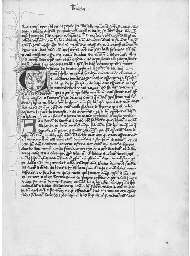




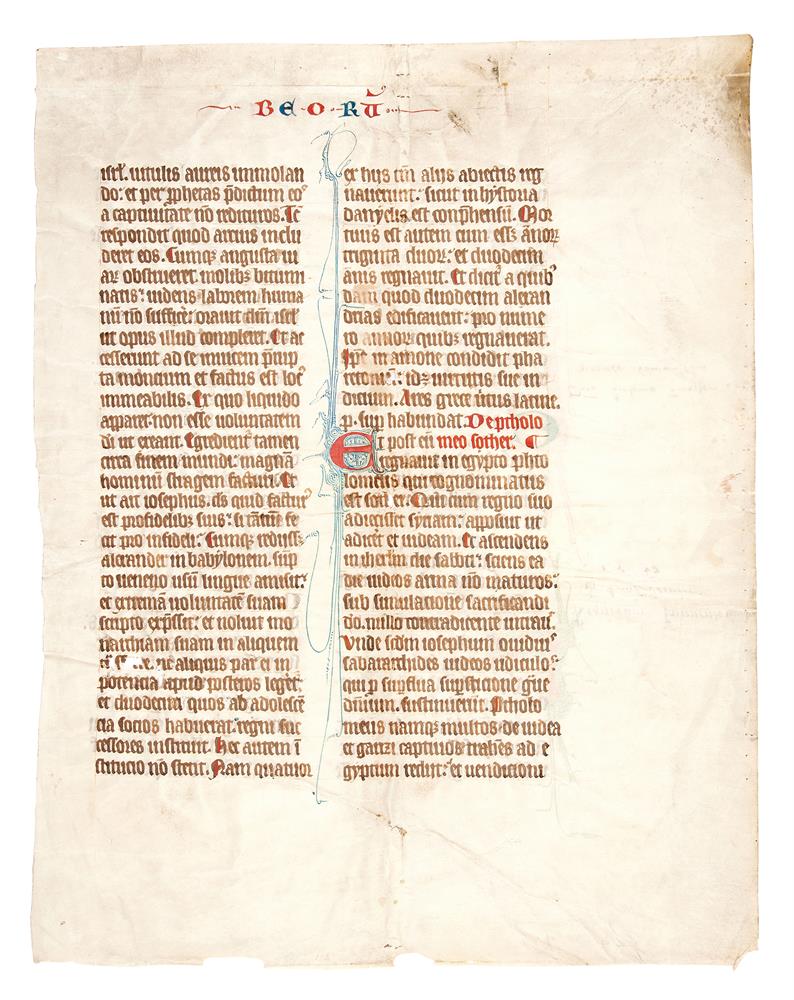

.jpg)
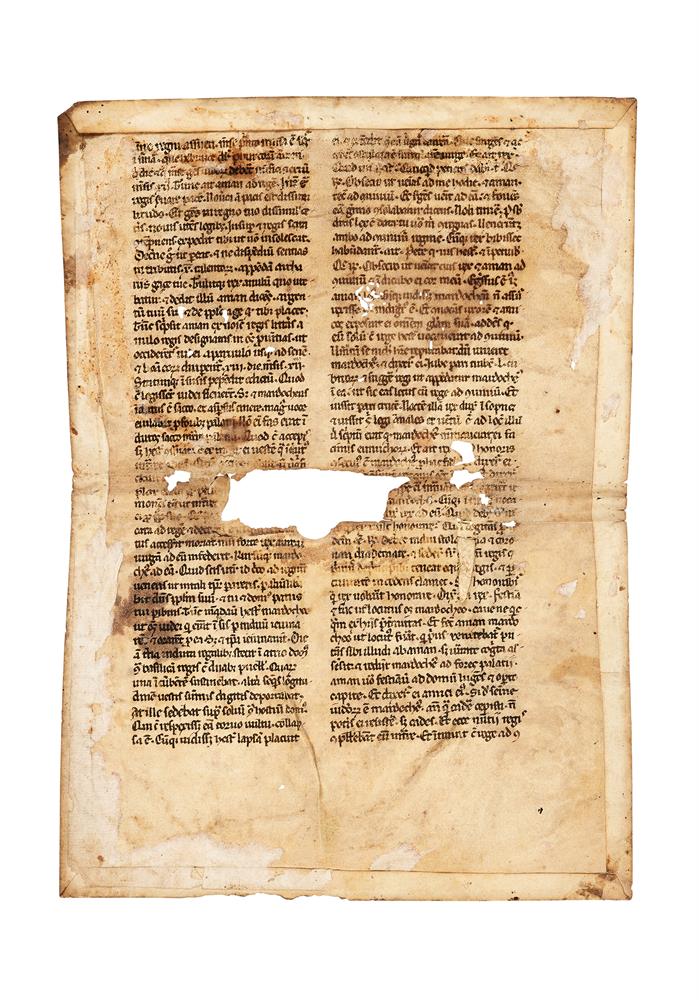

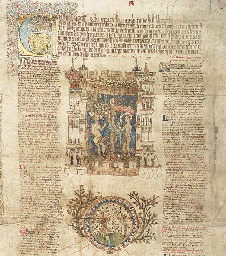


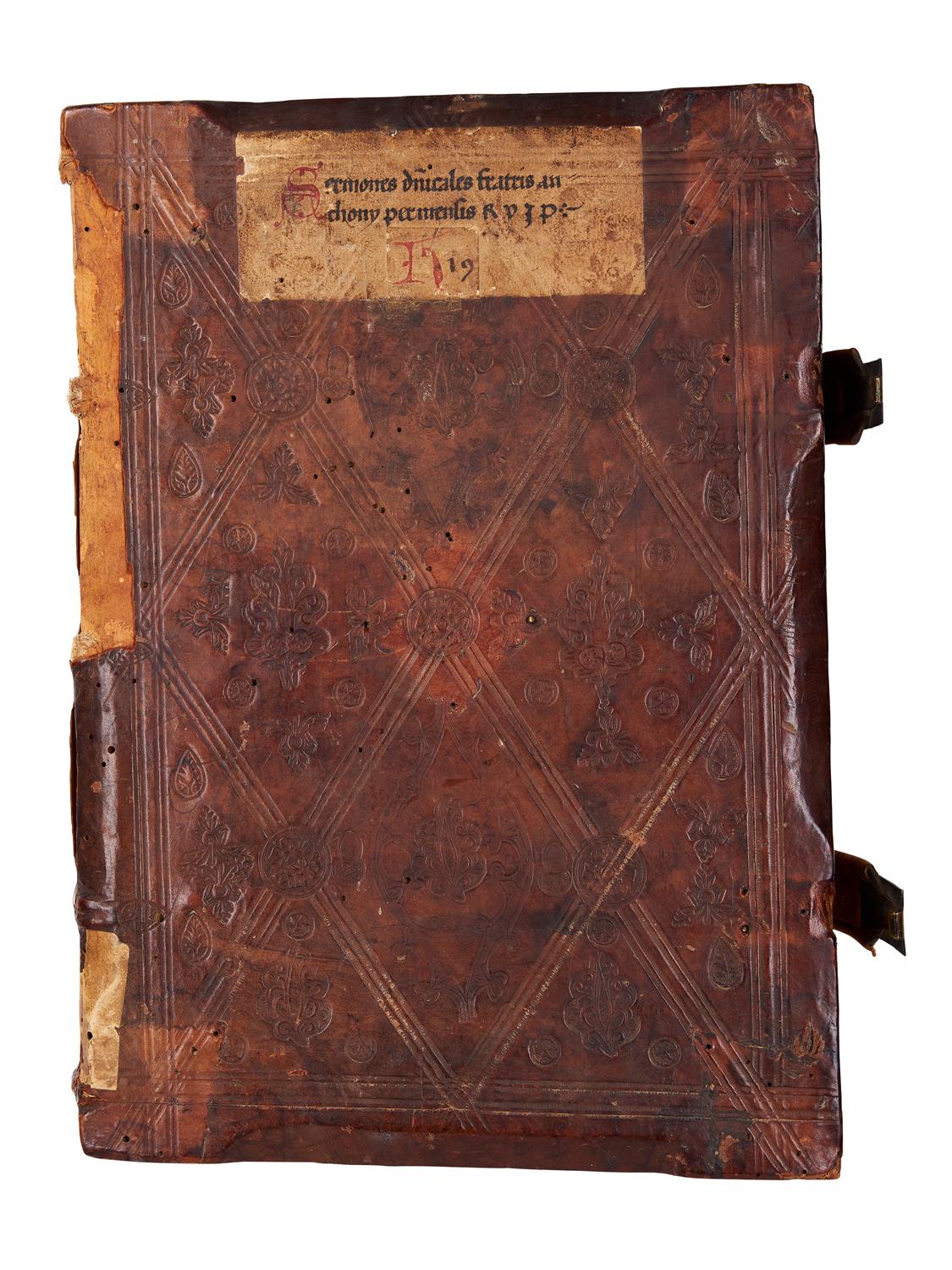
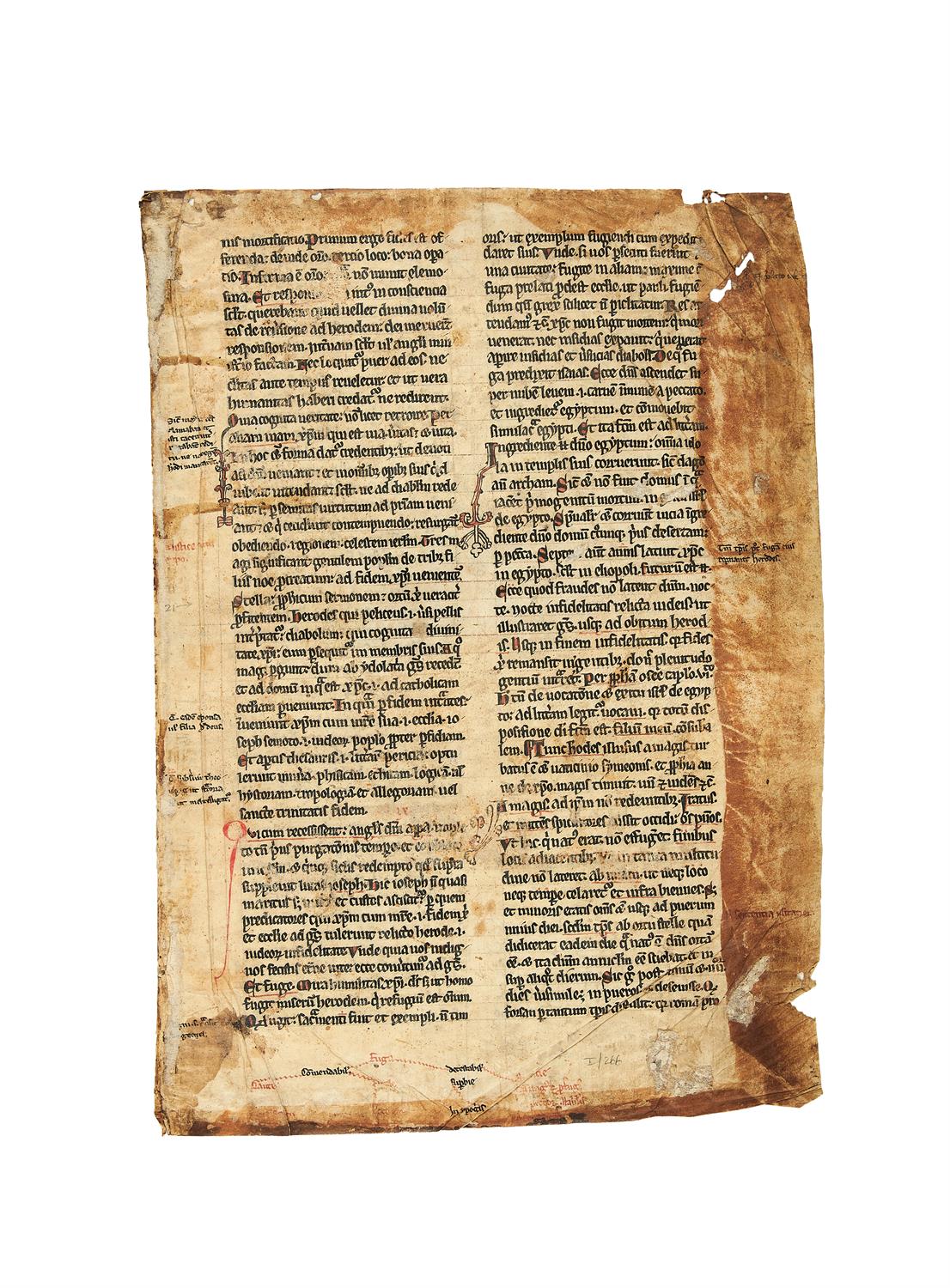
Try LotSearch and its premium features for 7 days - without any costs!
Be notified automatically about new items in upcoming auctions.
Create an alert